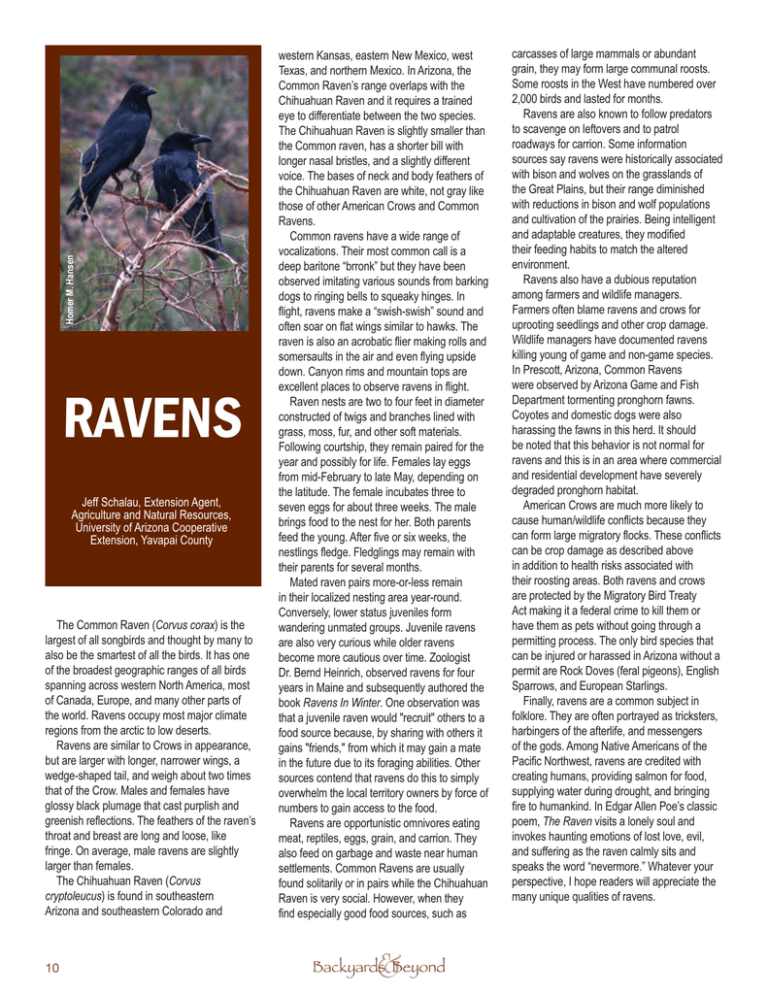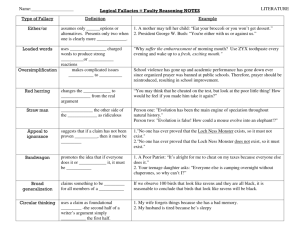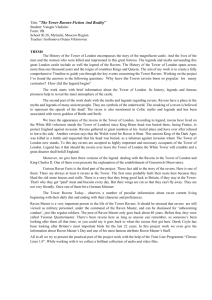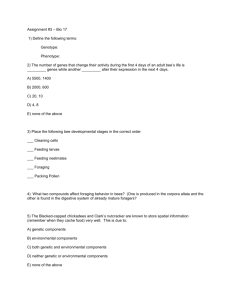carcasses of large mammals or abundant
advertisement

Homer M. Hansen RAVENS Jeff Schalau, Extension Agent, Agriculture and Natural Resources, University of Arizona Cooperative Extension, Yavapai County The Common Raven (Corvus corax) is the largest of all songbirds and thought by many to also be the smartest of all the birds. It has one of the broadest geographic ranges of all birds spanning across western North America, most of Canada, Europe, and many other parts of the world. Ravens occupy most major climate regions from the arctic to low deserts. Ravens are similar to Crows in appearance, but are larger with longer, narrower wings, a wedge-shaped tail, and weigh about two times that of the Crow. Males and females have glossy black plumage that cast purplish and greenish reflections. The feathers of the raven’s throat and breast are long and loose, like fringe. On average, male ravens are slightly larger than females. The Chihuahuan Raven (Corvus cryptoleucus) is found in southeastern Arizona and southeastern Colorado and 10 western Kansas, eastern New Mexico, west Texas, and northern Mexico. In Arizona, the Common Raven’s range overlaps with the Chihuahuan Raven and it requires a trained eye to differentiate between the two species. The Chihuahuan Raven is slightly smaller than the Common raven, has a shorter bill with longer nasal bristles, and a slightly different voice. The bases of neck and body feathers of the Chihuahuan Raven are white, not gray like those of other American Crows and Common Ravens. Common ravens have a wide range of vocalizations. Their most common call is a deep baritone “brronk” but they have been observed imitating various sounds from barking dogs to ringing bells to squeaky hinges. In flight, ravens make a “swish-swish” sound and often soar on flat wings similar to hawks. The raven is also an acrobatic flier making rolls and somersaults in the air and even flying upside down. Canyon rims and mountain tops are excellent places to observe ravens in flight. Raven nests are two to four feet in diameter constructed of twigs and branches lined with grass, moss, fur, and other soft materials. Following courtship, they remain paired for the year and possibly for life. Females lay eggs from mid-February to late May, depending on the latitude. The female incubates three to seven eggs for about three weeks. The male brings food to the nest for her. Both parents feed the young. After five or six weeks, the nestlings fledge. Fledglings may remain with their parents for several months. Mated raven pairs more-or-less remain in their localized nesting area year-round. Conversely, lower status juveniles form wandering unmated groups. Juvenile ravens are also very curious while older ravens become more cautious over time. Zoologist Dr. Bernd Heinrich, observed ravens for four years in Maine and subsequently authored the book Ravens In Winter. One observation was that a juvenile raven would "recruit" others to a food source because, by sharing with others it gains "friends," from which it may gain a mate in the future due to its foraging abilities. Other sources contend that ravens do this to simply overwhelm the local territory owners by force of numbers to gain access to the food. Ravens are opportunistic omnivores eating meat, reptiles, eggs, grain, and carrion. They also feed on garbage and waste near human settlements. Common Ravens are usually found solitarily or in pairs while the Chihuahuan Raven is very social. However, when they find especially good food sources, such as & Backyards Beyond carcasses of large mammals or abundant grain, they may form large communal roosts. Some roosts in the West have numbered over 2,000 birds and lasted for months. Ravens are also known to follow predators to scavenge on leftovers and to patrol roadways for carrion. Some information sources say ravens were historically associated with bison and wolves on the grasslands of the Great Plains, but their range diminished with reductions in bison and wolf populations and cultivation of the prairies. Being intelligent and adaptable creatures, they modified their feeding habits to match the altered environment. Ravens also have a dubious reputation among farmers and wildlife managers. Farmers often blame ravens and crows for uprooting seedlings and other crop damage. Wildlife managers have documented ravens killing young of game and non-game species. In Prescott, Arizona, Common Ravens were observed by Arizona Game and Fish Department tormenting pronghorn fawns. Coyotes and domestic dogs were also harassing the fawns in this herd. It should be noted that this behavior is not normal for ravens and this is in an area where commercial and residential development have severely degraded pronghorn habitat. American Crows are much more likely to cause human/wildlife conflicts because they can form large migratory flocks. These conflicts can be crop damage as described above in addition to health risks associated with their roosting areas. Both ravens and crows are protected by the Migratory Bird Treaty Act making it a federal crime to kill them or have them as pets without going through a permitting process. The only bird species that can be injured or harassed in Arizona without a permit are Rock Doves (feral pigeons), English Sparrows, and European Starlings. Finally, ravens are a common subject in folklore. They are often portrayed as tricksters, harbingers of the afterlife, and messengers of the gods. Among Native Americans of the Pacific Northwest, ravens are credited with creating humans, providing salmon for food, supplying water during drought, and bringing fire to humankind. In Edgar Allen Poe’s classic poem, The Raven visits a lonely soul and invokes haunting emotions of lost love, evil, and suffering as the raven calmly sits and speaks the word “nevermore.” Whatever your perspective, I hope readers will appreciate the many unique qualities of ravens.







